2017-05-31
Should white chefs sell burritos?
Should white chefs sell burritos?
Today is the Jewish holiday Shavuot, the conclusion of a seven-week counting period from the start of Passover, the day on which tradition tells us God gave the Torah to the Jewish people.
Or, more accurately, the day on which tradition tells us that God gave them the ten commandments, speaking to them directly. Apparently overwhelmed by the experience, the Jewish people then beg Moses to act as an intermediary, leading Moses to head up the mountain for forty days, returning with the physical tablets of the ten commandments, and with an oral transmission of the rest of the Torah.
As with all of Judaism, the details of that story have been studied and debated over the millennia since.
According to some rabbis, God spoke only the first commandment to the people directly: “Anochi Adonai Elohecha, asher hotzeticha mei’eretz mitzrayim mi’bait”, “I am the Lord, your God, Who took you out of the land of Egypt, out of the house of bondage.”
According to some others, God spoke only the first word of the first commandment, “Anochi”, a word of Egyptian origin meaning “I am.”
And still others say that God spoke only the first letter of that first word, the Hebrew letter aleph. But aleph is a silent letter – neither vowel nor consonant. It has no sound. So what and how did God speak in that silence? It’s an interesting question to ponder today, on Shavuot.
To that end, a poem I’ve long loved by former US Poet Laureate Billy Collins, “Silence”:
There is the sudden silence of the crowd
above a player not moving on the field,
and the silence of the orchid.The silence of the falling vase
before it strikes the floor,
the silence of the belt when it is not striking the child.The stillness of the cup and the water in it,
the silence of the moon
and the quiet of the day far from the roar of the sun.The silence when I hold you to my chest,
the silence of the window above us,
and the silence when you rise and turn away.And there is the silence of this morning
which I have broken with my pen,
a silence that had piled up all nightlike snow falling in the darkness of the house—
the silence before I wrote a word
and the poorer silence now.
Un-hooked: increasing focus in the age of distraction.
As I’ve written about before, the muscles in your feet are extremely important. When they’re engaged, your arch can absorb a huge amount of force, and the muscles further up the kinetic chain – in your legs and hips – work their best, too.
Whereas, when your arch collapses, every step smashes the small muscles and tendons in your feet. Worse, the navicular bone in your heel collapses inward, torquing your shin, and turning off muscles like your glute medius on the side of your hip. It’s a consistent cause of chronic pain in feet, knees, hips, and low-backs.
That’s why I’m a long-standing supporter of going barefoot: it allows you to use your feet (and, in turn, your legs) they way they’re meant to work.
Obviously, if you run along city streets (like I do here in NYC), you probably don’t want to go totally barefoot, should instead opt for some minimalist, zero-drop shoes. (I’m a big fan of Inov-8.) And if you’re working out in a commercial gym, even if you take off your shoes, you probably still want to keep on your socks, to avoid picking up infections like MRSA or ringworm from sweaty floors.
But when you’re padding around the house, you’re in the clear. And while you may already be taking off your shoes at the front door, there’s a big difference between going barefoot, and going sock-clad mostly barefoot.
First, though socks are more forgiving than shoes, they still squeeze your foot, preventing natural toe splay. Second, socks are slippery. Walking depends on friction – between your foot and the ground – to give you something to push against. Imagine walking on ice: with almost no friction between your shoes and the ground, you automatically start to take small, tentative, penguin-like steps, instead of natural human strides. Sure, socks on wood floor (or even carpet) aren’t nearly as slippery as shoes on ice. But they’re still slippery enough to change the way you walk, and to undercut the skill- and muscle-developing point of walking around barefoot in the first place.
So, in short, make a point to walk around your home without shoes – and without socks. It’s the healthiest thing to do.
Almost exactly a year ago, I blogged about how much I hate running. But also about how, precisely because it’s my biggest athletic weakness, I was focusing on running more, and on running better.
I ran through last summer, and into the fall. But by the time winter rolled around, I scaled back. I still hopped on the treadmill a few times a week to warm up before lifting, and tried to include 400m and 800m repeats in at least one metabolic conditioning session each week. But, all in, I could still count my total weekly mileage on one hand.
Now, warm weather is upon us again. This year, I no longer dread running, could lace up my sneakers and bang out a 10k at a moments notice. But I’d also be lapped on that 10k by many octogenarians. So I’m focusing this summer on not just surviving runs, but on actually doing them fast.
For the second day in a row, Jess and I are off to the Hudson Greenway, to get back in the swing of things with some long, slow distance. After that, it’s weeks of tempo runs and long and short intervals for me. I may still not be winning races, but I can at least move up to the front of the over-80 crowd.
Is pop music getting more repetitive?
Jess’ online dating profile included the phrase “mostly vegetarian,” so when I met her for dinner on one of our early dates, I pointed out a handful of vegetable-based entrees we might share.
“Actually,” she responded, “maybe the steak?”
Apparently, ‘mostly’ is a relative term.
We’ve since been touring through NYC’s essential burger joints, with stops at places like Burger Joint (my perennial favorite), The Spotted Pig (never quite as good as I’d like it to be), P.J. Clarke’s (good burgers, even better martinis), Bill’s Burger Bar (get the Fat Cat), Salvation Burger (though it’s a Spotted Pig spinoff, I prefer it to the original), Shake Shack (kind of like the band you used to see in a dive bar that then became a Top 50 radio act), Union Square Cafe (fancy!), etc.
Today, with beach-minded Memorial Day Weekend plans thwarted by inclement weather, we instead headed down to the West Village’s iconic Corner Bistro. Because, as New York magazine once put it, “if you call yourself a New Yorker, consider it your civic duty to have a beer and a burger here at least once.”
Admittedly, I’d already responded to that call of duty countless times over the past two decades, in part because Corner Bistro serves beer for under $5 (an NYC rarity), and in even larger part because they serve hamburgers into the wee hours of the night in a neighborhood the younger me often ended up in while totally blitzed.
Jess, however, had never been. And, though I frequented it more in the past, it had been a few years since I had returned (and a few more since I had while sober.) It seemed like an excellent adventure. Away we went.
The restaurant itself is essentially a dive bar, with about a dozen seats around an old mahogany bar in the front, and about a dozen small tables in the brick-walled, tin-roofed back.
The real draw is the food, despite a fairly minimalist menu:
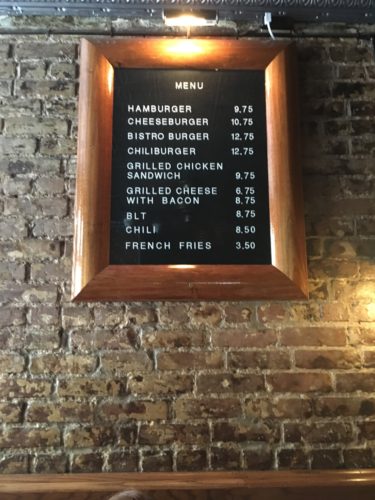
And, honestly, even that’s more info than you need. You just want the cheeseburger with a side of fries. Or maybe two cheeseburgers and a side of fries.
Usually, there’s a line out the door. But today, despite (or perhaps because of?) it being Memorial Day Weekend, we breezed in and were seated immediately.
We ordered beer (still miraculously sub-$5) while we waited, Jess the Brooklyn Lager, and me a McSorley’s Ale (the house brew from NYC’s oldest continuously operated saloon):
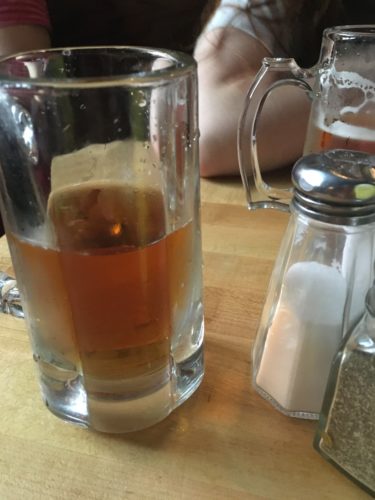
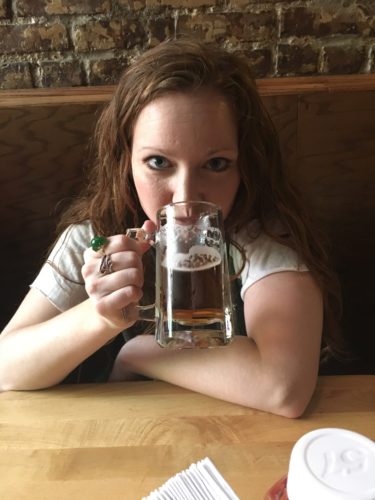

Next arrived our fries, served (like everything at Corner Bistro) on paper plates. They were delightfully crispy, though a bit short on flavor – the texture of a McDonald’s fry (which, even for food snobs, is kind of the platonic ideal of skinny french fry), yet somehow without that much taste.
Nonetheless, as we were coming to lunch after a morning run along the Hudson River bike path, we were starved, and I polished off half my plate before Jess reminded me that I had intended to photograph the meal. (On the plus side, that’s definitive proof that, though I’m just months outside the 1980 birthdate cutoff, I’m most certainly not a Millennial.)
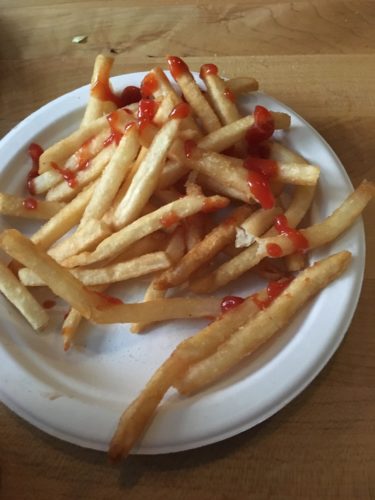
The burger itself is a half-pound of beef, layered between an onion slice below and dill pickle, tomato, and iceberg lettuce on top, all packed onto a not-terribly-large, possibly-from-a-bag bun:
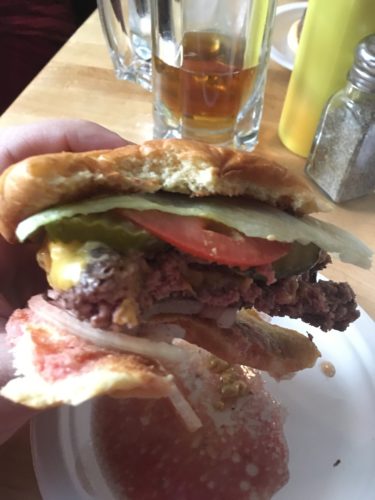
Or, as seen intact and from above (on Jess’ plate, as the following picture was actually taken after the above one, given that I generally eat like a starving feral animal, and had polished off half of my half-pound burger while she was still genteelly applying mustard):
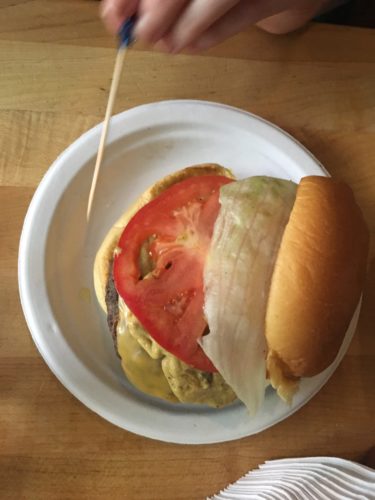
Regardless, despite the slow start, Jess eventually caught up.
Me:
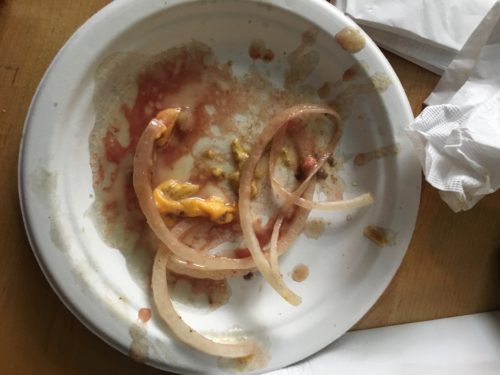
Her:
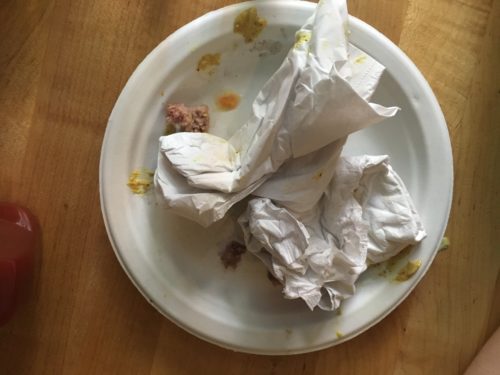
At that point, I was still strongly considering a second burger, as I usually had in the past. But, in my age and wisdom, and with a greater appreciation for the law of diminishing returns, I decided I probably didn’t need to eat a full pound of hamburger for lunch, especially if my plans for the balance of the day included anything besides lying on the floor, digesting.
So, adventure complete, and Jess’ Corner Bistro NYC civic duty fulfilled. Though, honestly, I don’t think we’ll be headed back any time soon. It’s a very good burger, and in decades past it held a much-deserved spot on pretty much any ‘Five Best Burgers in NYC’ list. But, in today’s culinary world, there are just a whole lot of great hamburgers, and even a whole lot of better hamburgers, in the city.
Final verdict: if you’ve never been, go. If you have, don’t rush back.
“Double King“.
“Like our good friend Warren Buffett, I measure my happiness by whether people close to me are happy and love me, and by the difference I make in other people’s lives.”
– Bill Gates
Consider (the economics of) the lobster.